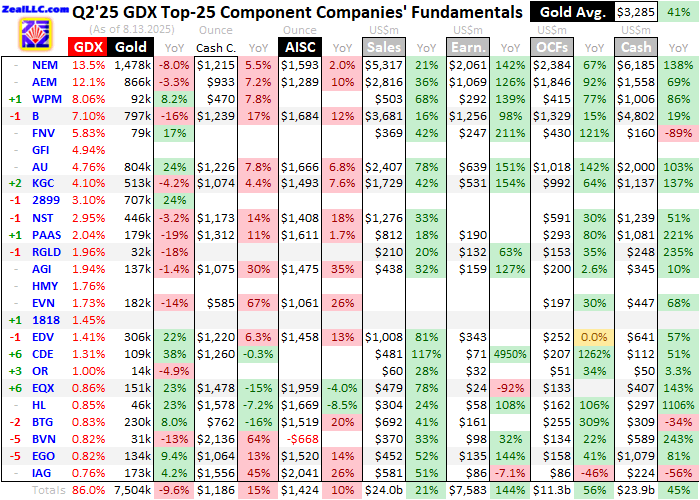Gold Miners’ Q2’25 Fundamentals
Gold miners just finished reporting their best quarterly results ever. Mainly thanks to amazing record gold prices, its miners achieved epic record revenues, record unit profits, record bottom-line earnings, and record operating cashflows. Last quarter proved gold miners’ eighth in a row of huge mostly-high-double-digit profits growth. Gold stocks remain seriously undervalued relative to this awesome fundamental backdrop.
The GDX VanEck Gold Miners ETF remains this sector’s dominant benchmark. Birthed way back in May 2006, GDX has parlayed its first-mover advantage into an insurmountable lead. Its $17.1b of net assets mid-week dwarfed the next-largest similar competitor ETF’s by over 10x! GDX is undisputedly the trading vehicle of choice in this sector, with the world’s biggest gold miners commanding most of its weighting.
Gold-stock tiers are defined by miners’ annual production rates in ounces of gold. Small juniors have little sub-300k outputs, medium mid-tiers run 300k to 1,000k, large majors yield over 1,000k, and huge super-majors operate at vast scales exceeding 2,000k. Translated into quarterly terms, these thresholds shake out under 75k, 75k to 250k, 250k+, and 500k+. Those two largest categories account for nearly 56% of GDX.
The majors are enjoying a banner 2025, with GDX soaring 71.2% year-to-date! That has amplified gold’s parallel upside by 2.6x, getting higher in major gold stocks’ usual historical range of 2x to 3x. And that’s part of a bigger 124.7% bull run stretching back to early October 2023, when gold’s mighty cyclical bull was born. That has catapulted the yellow metal 88.6% higher at best so far, without a single 10%+ correction!
Yet gold stocks have really underperformed during that span, with GDX only hitting 1.4x upside leverage. The main reason is likely the AI stock bubble enthralling and distracting investors, leaving everything else languishing in its towering shadow. But gold stocks are increasingly catching up, and GDX is actually on all-time-record-high watch. Its first record close in a shocking 13.9 years is merely 14.7% above midweek levels!
For 37 quarters in a row now, I’ve painstakingly analyzed the latest operational and financial results from GDX’s 25-largest component stocks. Mostly super-majors, majors, and larger mid-tiers, they dominate this ETF at 86.0% of its total weighting! While digging through quarterlies is a ton of work, understanding the gold miners’ latest fundamentals really cuts through the obscuring sentiment fogs shrouding this sector.
This table summarizes the operational and financial highlights from the GDX top 25 during Q2’25. These gold miners’ stock symbols aren’t all US listings, and are preceded by their rankings changes within GDX over this past year. The shuffling in their ETF weightings reflects shifting market caps, which reveal both outperformers and underperformers since Q2’24. Those symbols are followed by their current GDX weightings.
Next comes these gold miners’ Q2’25 production in ounces, along with their year-over-year changes from the comparable Q2’24. Output is the lifeblood of this industry, with investors generally prizing production growth above everything else. After are the costs of wresting that gold from the bowels of the earth in per-ounce terms, both cash costs and all-in sustaining costs. The latter help illuminate miners’ profitability.
That’s followed by a bunch of hard accounting data reported to securities regulators, quarterly revenues, earnings, operating cash flows, and resulting cash treasuries. Blank data fields mean companies hadn’t disclosed that particular data as of the middle of this week. The annual changes aren’t included if they would be misleading, like comparing negative numbers or data shifting from positive to negative or vice-versa.
With last quarter’s average gold prices blasting up 40.6% YoY to a stunning record $3,285, gold miners’ Q2’25 results were destined to be stellar! And they certainly didn’t disappoint, stacking countless records like I predicted in my Q2’25-results preview in late June. Major gold miners’ fundamentals have never been stronger, arguing for much-higher gold-stock prices as investors increasingly grow aware of all this.
Collecting and analyzing all this quarterly-results data is quite challenging. And that’s coming from someone especially suited for it. I’ve been intensely researching, actively trading, and writing about gold stocks in our popular subscription newsletters for over 25 years now. After university I started my career auditing mining companies, and have maintained an active Certified Public Accountant license for over 28 years.
I still find immersing myself in quarterly management-discussion-and-analysis and financial-statement reports fascinating. Plenty of major gold miners are great reporters, presenting this essential information to shareholders in straightforward manners. But others drag their feet or intentionally obscure important data, particularly from foreign countries with way-inferior accounting standards. Those can distort GDX analyses.
The worst reporters by far are the big Chinese gold miners Zijin Mining and Zhaojin Mining, which trade in Hong Kong with those numeric symbols above. Their English reporting is haphazard and sporadic, and even their Chinese reporting mostly ignores crucial operational data. On the bright side they rarely report quarterly results in timely fashions, so they usually aren’t skewing GDX-top-25-results quarterly comparisons.
But the big South African gold miners are more problematic. They report in half-year increments instead of quarterly, which is fine. That’s also true for Australian and British gold miners. The South African majors used to publish quarterly updates, but those inexplicably stopped some years ago. So neither Gold Fields nor Harmony Gold Mining have released any Q2’25 results at all yet, distorting GDX-top-25 comparability.
Last quarter the GDX top 25’s overall production plunged 9.6% YoY to 7,504k ounces. That’s their worst collective output in at least the last 37 quarters! Compounding the ominousness of that, the World Gold Council reported that overall world gold-mining output actually grew 3.2% YoY in Q2’25 to hit 40,149k ounces. That makes it look like GDX majors aren’t faring well, but it’s all because of lazy South African reporting.
To maintain the best-possible database, in subsequent quarters I add late results from past quarters. So if large majors GFI’s and HMY’s output is excluded from the comparable Q2’24, the rest of the GDX top 25 actually saw production edge up 0.5% YoY! That’s not bad considering bigger majors often suffer from declining output, unable to overcome depletion at their vast operating scales. That happens almost every quarter.
Note above roughly the upper half of the GDX top 25 with the largest gold miners mostly saw declining gold production last quarter. Most of the growth came in the smaller mid-tier gold miners in the bottom half. Newmont and Barrick Mining which have mostly been the world’s largest gold miners for decades saw Q2’25 output drop 8.0% and 15.9% YoY! Unfortunately that’s been par for the course for long years now.
Persistently-declining output creates mounting problems for gold miners mired in it. Fewer ounces force up unit mining costs, slowing earnings growth and operating-cashflow generation needed for expansions and new mine-builds. That leaves afflicted gold miners more susceptible to falling behind depletion, and saddled with aging higher-cost mines. So prudent investors tend to avoid gold stocks with deteriorating production.
Often large majors’ dominant growth strategy is via super-expensive acquisitions, occasionally buying out smaller competitors to take over their gold mines. But since acquirers always way-overpay, later on large chunks of those huge purchase prices are written off. Those big-to-huge goodwill writedowns flushed through income statements heavily impair long-term profitability, leaving those gold stocks comparatively overvalued.
Unit gold-mining costs are generally inversely proportional to gold-production levels. That’s because gold mines’ total operating costs are largely fixed during pre-construction planning stages, when designed throughputs are determined for plants processing gold-bearing ores. Their nameplate capacities don’t change quarter-to-quarter, requiring similar levels of infrastructure, equipment, and employees to keep running.
So the primary variable driving quarterly gold production is the ore grades fed into these plants. Those vary widely even within individual gold deposits. Richer ores yield more ounces to spread mining’s big fixed expenses across, lowering unit costs and boosting profitability. But while fixed costs are the lion’s share of gold mining, there are also sizable variable costs. That’s where recent years’ raging inflation hit hard.
Cash costs are the classic measure of gold-mining costs, including all cash expenses necessary to mine each ounce of gold. But they are misleading as a true cost measure, excluding the big capital needed to explore for gold deposits and build mines. So cash costs are best viewed as survivability acid-test levels for the major gold miners. They illuminate the minimum gold prices necessary to keep the mines running.
Last quarter the GDX top 25’s average cash costs surged 14.5% YoY to $1,186 per ounce. That was a new record high, skewed by one extreme outlier. Peru’s Buenaventura reported cash costs skyrocketing 64.4% YoY to a stunning $2,136! Gold isn’t the main focus of this polymetallic miner, accounting for just 28% of its Q2’25 revenue. Excluding BVN, the rest of the GDX top 25 reported better cash costs of $1,131.
The key takeaway is major gold miners’ cash costs remain far below these awesome record prevailing gold prices, which again averaged $3,285 last quarter. These actual expenses necessary to produce gold are also naturally the largest component of broader all-in sustaining costs. So if gold miners can keep cash costs under control, AISCs are tamed too. AISCs way under gold make for super-profitable mining.
All-in sustaining costs are far superior than cash costs, and were introduced by the World Gold Council in June 2013. They add on to cash costs everything else that is necessary to maintain and replenish gold-mining operations at current output tempos. AISCs give a much-better understanding of what it really costs to maintain gold mines as ongoing concerns, and reveal major gold miners’ true operating profitability.
The GDX-top-25 gold miners’ average AISCs climbed 10.5% YoY to $1,424 per ounce in Q2’25. Back in late June’s Q2-preview essay, I analyzed why “there’s a reasonable degree of certainty Q2’s will come in somewhere between $1,375 to $1,425.” But nearly a month before earnings season began, I suspected “they will be on the lower side due to quarterly-gold-output dynamics.” My estimate for this quarter was $1,375.
So one of my primary focuses reading through quarterly reports was why AISCs came in higher. They certainly weren’t a problem at $1,424, far below prevailing gold prices and merely the third-highest on record despite outlying record gold. One reason was IAMGOLD dragged the average higher with its AISCs surging 26.2% YoY to $2,041 per ounce. Recently anything over $2,000 has tended to give investors pause.
Normally higher mining costs are driven by lower-than-expected ore grades or mill throughputs. And IAG did experience some of that, mainly from a slower ramp-up of its newest gold mine that went commercial just over a year ago. But this company reported the main driver was higher royalty expenses, which scale with prevailing gold prices! IAMGOLD said that added about $65 to AISCs compared to its 2025 guidance.
As I pored through quarterlies in these past couple weeks, their most striking new theme was widespread reports of higher royalties pushing up AISCs. One mid-tier now ranking 53rd in GDX running three gold mines across central Africa reported due to royalties “every $100 per ounce increase in the price of gold results in $15 per ounce higher consolidated AISC” for it. It had based its 2025 AISC guidance on $2,500 gold.
Although not all GDX-top-25 majors pay royalties, plenty do. I’d guess a sizable chunk of their 10.5%-higher AISCs, maybe half, came from higher royalties. There were other gold-price-driven expenses also mentioned as pushing up AISCs. Alamos Gold had to pay higher royalties as well, but also mentioned its share-based-compensation expenses contributed to higher AISCs. Higher gold prices pushed up share prices.
A sizable fraction of the GDX top 25 either warned full-year AISCs would shake out near the upper ends of their original guidance ranges, or they raised those ranges somewhere around 10% at the midpoint. Markets’ reactions to higher AISCs were mixed. That 53rd-ranked African gold miner Allied Gold reported Q2 AISCs soared 55.7% YoY to an ugly $2,343! But it forecast them falling near $1,850 in 2025’s second half.
Traders slammed its stock 11.9% lower that day on those higher mining costs. Yet meanwhile that same day, GDX’s 28th-largest component OceanaGold also reported high AISCs of $2,027. Yet they were still 4.9% lower than Q2’24’s, and this company reaffirmed 2025 midpoint guidance of $1,975. So that stock soared 10.3% on lower mining costs despite $2k+ AISCs! Equinox Gold had a similar outcome with high costs.
This Canadian gold miner didn’t report its Q2 results until late Wednesday evening, maximizing Canada’s looser financial-reporting deadline. Its AISCs ran $1,959, near $2k but they did retreat 4.0% YoY. Its full-year projections originally had a solid $1,503 midpoint, but in mid-June that was hiked to $1,850 due to a slower new-mine ramp-up. That was reaffirmed in Q2 results, yet EQX stock soared 15.2% Thursday!
I’d be remiss on GDX-top-25 average AISCs if I didn’t mention Buenaventura’s negative ones which drag down the average. Its crazy -$668 per ounce in Q2 is nothing new, those ran -$578, -$680, +$708, and -$852 in the four quarters leading into this latest one. BVN has a primary copper mine it treats as a gold one, with epic byproduct credits of -$39,772 per ounce in Q2’25! That mine’s gold AISCs ran -$6,618 last quarter!
Excluding BVN, the rest of the GDX top 25 averaged $1,563 AISCs in Q2’25. That number is interesting as their current 2025 guidances average similar midpoints of $1,537. For the entire 37-quarter history of this research thread, I’ve never excluded any AISCs from the GDX-top-25 averages including plenty of ugly high-side outliers. So for consistency’s stake Buenaventura’s low extreme outlier also has to remain in.
Interestingly GDX composition changes could still drag down AISCs. The lower end of the top 25 has seen plenty of movement in recent quarters as investors bid up stock prices of better mid-tiers. GDX’s 27th and 29th components are currently New Gold and Orla Mining, which could enter the top 25. These great mid-tiers’ 2025 midpoint AISC projections are now running just $1,075 and $1,450, well under many peers’.
After my quarter-century-plus of relentlessly studying this sector, I’ve found the best metric for measuring gold miners’ collective fundamental performance is their implied unit earnings. That simply subtracts the GDX-top-25 average AISCs from the quarterly-average gold price. This is way cleaner than bottom-line accounting profits, since a varying GDX-top-25 subset’s are usually distorted by big noncash charges or gains.
Last quarter’s astounding record $3,285 gold less those $1,424 GDX-top-25 average AISCs yields huge sector per-ounce profits of $1,861. That skyrocketed a stupendous 77.6% YoY, and is the highest ever achieved by major gold miners! It shattered the preceding two quarters’ last two records of $1,207 and $1,470. And those epic record Q2’25 profits were just the latest in a long trend of phenomenal earnings growth.
Over the last eight quarters ending Q2’25, these GDX-top-25 implied unit earnings soared 87%, 47%, 31%, 75%, 74%, 78%, 90%, and 78% YoY! Has there ever been an entire stock-market sector rivaling such persistent and massive earnings growth? I don’t know, but the gold miners ought to be among the hottest sectors in all the markets with that kind of track record! Investors should be flooding in with a vengeance.
And this epic streak isn’t over yet. Halfway through this current Q3’25, gold is averaging another record $3,349. If something like that holds, gold would soar another 35%ish year-over-year. Again the GDX-top-25’s average AISC midpoint guidance is $1,537, though plenty of gold miners see lower AISCs in the second half as production rises. But at this point Q3 is tracking for GDX-top-25 implied unit earnings near $1,812.
That would skyrocket another 73% YoY over Q3’24 levels! And there’s some strong bullish arguments for gold’s mighty cyclical bull continuing to power higher on balance. Leading them is American stock investors finally increasingly chasing gold again. They had largely ignored most of its huge bull run because the AI stock bubble sucked all the air out of the room. Better gold prices would drive mining profits much higher.
The GDX top 25’s hard accounting results reported to securities regulators all hit epic records too. Total revenues climbed 21.2% YoY to $23,984m. But that is distorted by one of those South African majors’ late reports in the comparable quarter. Excluding it, the GDX top 25’s sales soared 37.4% YoY. That’s about what you’d expect with 0.5%-higher adjusted production coupled with 40.6%-higher gold prices.
Even without those big Chinese and South African miners in Q2’25, the GDX top 25’s bottom-line accounting profits skyrocketed 144.2% YoY to a colossal $7,583m! That wasn’t just a dazzling all-time record, but a clean one. I comb through every GDX-top-25 income statement looking for unusual one-off charges or gains distorting net income. The only notable one in Q2’25 was Newmont’s $699m gain on assets held for sale.
But that was mostly offset in the comparable Q2’24, when Equinox reported a $470m gain recognized on remeasuring a previously-held interest in a mine after it acquired the entire stake. And those record GDX-top-25 profits were all the more remarkable because some prior quarters had seen the Chinese gold miners report them. Gold-mining earnings were off-the-charts huge last quarter, the best they’ve ever seen by far!
Case in point for that was the world’s largest gold miner, top GDX component, and only gold stock in the S&P 500 Newmont. Its Q2 compared to its peers was on the weaker side operationally, with production falling 8.0% YoY and AISCs climbing 2.0% to a higher $1,593 per ounce. Yet its stock blasted up 6.9% on results day, because its bottom-line profits and adjusted earnings per share skyrocketed 142% and 99% YoY!
The major gold miners’ operating cashflows also soared 56.2% YoY to a record $11,287m, catapulting their collective cash hoards 45.5% higher to a huge $23,911m. The gold miners printing money hand over fist in this environment are amassing tens of billions they will use to expand existing mines and build new ones. That will help them make better progress in overcoming depletion, boosting future profitability.
The gold miners just achieved another epic record quarter, yet their stocks remain seriously undervalued. Unbelievably plenty are trading at single-digit-to-teens trailing-twelve-month price-to-earnings ratios, and in some cases those don’t yet include Q2’25’s new windfall profits! And again historically GDX amplified material gold moves by 2x to 3x. Yet so far GDX’s bull run is only up 124.7% at best to gold’s 88.6% at best.
That poor 1.4x leverage is really lagging decades of precedent. Relative to gold’s mighty-cyclical-bull gains so far, GDX’s parallel run ought to be sporting 177% to 266% gains today! In GDX-price terms, that runs from $71.81 to $94.77. That’s another 24% to 63% higher from midweek levels, highly-probable coming gains well worth chasing. During gold’s last 40%+ monster upleg, GDX amplified its bull run a great 3.4x!
Successful trading demands always staying informed on markets, to understand opportunities as they arise. We can help! For decades we’ve published popular weekly and monthly newsletters focused on contrarian speculation and investment. They draw on my vast experience, knowledge, wisdom, and ongoing research to explain what’s going on in the markets, why, and how to trade them with specific stocks.
Our holistic integrated contrarian approach has proven very successful, and you can reap the benefits for only $10 an issue. We extensively research gold and silver miners to find cheap fundamentally-superior mid-tiers and juniors with outsized upside potential. Sign up for free e-mail notifications when we publish new content. Even better, subscribe today to our acclaimed newsletters and start growing smarter and richer!
The bottom line is the major gold miners dominating GDX just achieved their best quarter in history by far. Dazzling record gold prices fueled record revenues, record unit profits, record bottom-line earnings, and record operating cashflows. This is nothing new for gold miners, their eighth consecutive quarter of skyrocketing per-ounce earnings. Yet gold-stock prices are still way undervalued relative to these epic fundamentals.
This extreme anomaly can’t and won’t last, gold stocks have to revalue way higher. Their latest record earnings season is growing investor interest, as evidenced by GDX increasingly outperforming gold this summer. This dominant gold-stock benchmark isn’t far from new record highs, which will spawn much more bullish financial-media coverage driving more buying. Gold stocks have a lot more bull running ahead.
********

















